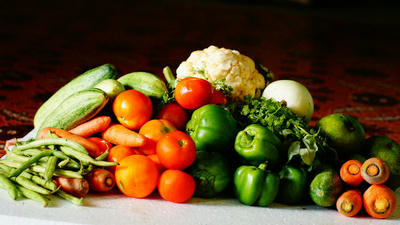
Food is a fundamental part of our lives, and what we eat can significantly impact our health, taste experiences, and enjoyment of cooking. One of the most effective ways to elevate your culinary skills and enhance your meals is to embrace the concept of cooking with seasonal ingredients. Not only does this practice support local farmers and sustainable agricultural practices, but it also allows you to enjoy the freshest and most flavorful produce available.
The Benefits of Cooking with Seasonal Ingredients
Cooking with seasonal ingredients offers numerous benefits that can transform your meals and your relationship with food. Here are some key advantages of embracing seasonality in your cooking:
Improved Flavor and Freshness
Seasonal ingredients are typically harvested at their peak ripeness and are, therefore, more flavorful and nutritious than out-of-season produce. For instance, tomatoes picked in the height of summer taste vastly better than those available in winter. Fresh produce that is in season often requires minimal seasoning, allowing its natural flavors to shine through.
Enhanced Nutritional Value
Fruits and vegetables that are in season contain higher nutrient levels compared to those that have traveled long distances or been stored for extended periods. Seasonal foods are often picked closer to peak ripeness, maximizing their vitamins and minerals. This means you are not only enjoying tastier meals but healthier ones as well.
Supporting Local Agriculture
By choosing seasonal ingredients, you often support local farmers and agricultural practices. Farmers’ markets and community-supported agriculture programs provide fresh produce directly from local sources, reducing the carbon footprint associated with transporting food over long distances. Supporting local farms also contributes to the sustainability of your community.
Variety and Culinary Adventure
Cooking with seasonal ingredients encourages you to experiment with new foods you may not typically use. Each season brings a fresh array of fruits, vegetables, and herbs, challenging you to think creatively in the kitchen. This variety enables you to expand your culinary repertoire and discover new favorite ingredients and recipes.
Cost Efficiency
Seasonal ingredients are often more affordable since they are abundant and require less shipping and storage. Buying in-season produce can lead to significant savings at the grocery store or farmers’ market. Additionally, many items can be preserved for later use, allowing you to save money in the long run.
Understanding Seasonality: A Seasonal Produce Calendar
Understanding what ingredients are in season can vary by region, but here is a general guide to help you navigate seasonal produce throughout the year:
Spring
- Fruits: Strawberries, cherries, rhubarb, apricots.
- Vegetables: Asparagus, peas, radishes, spinach, artichokes, spring onions.
Summer
- Fruits: Tomatoes, zucchini, peaches, blueberries, watermelon, blackberries.
- Vegetables: Bell peppers, corn, cucumbers, eggplant, squash.
Fall
- Fruits: Apples, pears, figs, grapes, pomegranates.
- Vegetables: Pumpkins, squash, sweet potatoes, root vegetables, Brussels sprouts.
Winter
- Fruits: Citrus fruits (oranges, lemons, grapefruits), kiwi, persimmons.
- Vegetables: Kale, cabbage, carrots, turnips, leeks, sweet potatoes, beets.
This calendar serves as a basic reference; however, be sure to check local resources for accurate seasonal produce availability in your area.
Shopping at Farmers' Markets: Tips and Tricks
Farmers' markets are excellent places to discover seasonal ingredients while directly supporting local producers. Here are some tips for making the most of your farmers' market experience:
Arrive Early
To get the freshest produce, arrive early when vendors are setting up and stocking their tables. This also ensures you have a wider selection of items to choose from.
Bring Reusable Bags
Help reduce waste by bringing your reusable bags. Farmers’ markets may not always provide bags, so having your own will make your shopping experience more convenient.
Talk to the Farmers
Engage with the vendors and ask questions about their produce, farming practices, and seasonal availability. They can provide valuable insight into how to best use their ingredients and recommendations for cooking.
Be Open to New Experiences
Explore new fruits and vegetables that you may not usually buy. The beauty of seasonal cooking is the opportunity to experiment with different flavors and textures. Ask how to prepare unfamiliar items or seek out new recipe ideas.
Consider the Weather
Local weather patterns can affect what is available at markets. If you know a particular crop has been experiencing difficulties due to drought or excessive rain, this may influence availability. Being adaptable in your meal planning helps you make the most of what is fresh.
Follow the Seasons
Plan your shopping trips based on what is in season, allowing you to take advantage of the freshest, most flavorful ingredients available.
Meal Planning with Seasonal Ingredients
Planning your meals around seasonal ingredients can enhance your cooking experience and simplify your shopping. Here are some strategies to effectively meal plan with seasonal produce:
Create a Weekly Menu
Take a few minutes each week to brainstorm meals based on what is in season. This will help you make informed decisions when shopping, ensuring that you maximize freshness and flavor.
Keep It Simple
Focus on simple recipes that highlight seasonal ingredients. You don’t need to overcomplicate dishes; fresh produce shines with minimal preparation. A dash of olive oil, a sprinkle of salt, and some herbs can elevate flavors tremendously.
Batch Cooking and Freezing
Consider batch cooking foods that are in season, like soups, sauces, and jams, for future meals. Freezing seasonal produce can also preserve its flavor and nutritional value, allowing you to enjoy it later in the year.
Substitute Ingredients
If you are missing a specific seasonal ingredient, try substituting it with something else that is in season and complements your dish. This practice encourages creativity and flexibility in the kitchen.
Maintain a Seasonal Pantry
Regularly stock up on pantry staples that complement seasonal ingredients, such as grains, beans, and dried herbs. Having a well-stocked pantry allows you to whip up meals easily using fresh produce.

Delicious Recipes for Seasonal Cooking
Now that we've explored the benefits of cooking with seasonal ingredients and how to plan your meals, here are some delicious recipes to inspire your kitchen adventures. Each recipe showcases the beauty of using fresh produce in season.
Spring Asparagus Risotto
Ingredients:
- 1 cup Arborio rice
- 1 bunch fresh asparagus, trimmed and cut into 1-inch pieces
- 1 small onion, diced
- 4 cups vegetable broth
- 1/2 cup dry white wine
- 1/2 cup grated Parmesan cheese
- 2 tablespoons olive oil
- Salt and pepper to taste
- Chopped fresh parsley for garnish
Instructions:
- In a pot, bring the vegetable broth to a simmer and keep it warm.
- In a separate pan, heat olive oil over medium heat and add diced onion. Sauté until translucent, about 5 minutes.
- Add Arborio rice and toast for 1-2 minutes, stirring constantly.
- Pour in the white wine and cook until absorbed.
- Gradually add warm broth, one ladle at a time, stirring often, until the rice is al dente.
- Add asparagus pieces when the rice is about 10 minutes from being done. Stir in Parmesan cheese, and season with salt and pepper.
- Garnish with fresh parsley before serving.
Summer Vegetable Ratatouille
Ingredients:
- 1 eggplant, diced
- 1 zucchini, sliced
- 1 bell pepper, chopped
- 1 onion, diced
- 2 tomatoes, peeled and chopped
- 3 cloves garlic, minced
- 1/4 cup olive oil
- Fresh basil leaves for garnish
- Salt and pepper to taste
Instructions:
- In a large skillet, heat olive oil over medium heat. Sauté onion and garlic until fragrant.
- Add eggplant, zucchini, and bell pepper. Cook until vegetables soften, about 5-7 minutes.
- Stir in tomatoes, salt, and pepper. Cover and simmer for another 10-15 minutes, stirring occasionally.
- Remove from heat and let stand for a few minutes. Garnish with fresh basil before serving.
Fall Pumpkin Soup
Ingredients:
- 1 medium pumpkin, peeled and cubed
- 1 onion, diced
- 3 cloves garlic, minced
- 4 cups vegetable or chicken broth
- 1 teaspoon ground cumin
- 1 teaspoon ground nutmeg
- 2 tablespoons olive oil
- Salt and pepper to taste
- Toasted pumpkin seeds for garnish
Instructions:
- In a large pot, heat olive oil over medium heat. Sauté the onion and garlic until softened.
- Add cubed pumpkin, cumin, nutmeg, salt, and pepper. Stir to combine.
- Pour in the broth and bring to a boil. Reduce heat and simmer until the pumpkin is tender, about 20 minutes.
- Use an immersion blender or regular blender to puree the soup until smooth.
- Serve hot, garnished with toasted pumpkin seeds.
Winter Citrus Salad
Ingredients:
- 2 cups mixed greens
- 1 grapefruit, segmented
- 1 orange, segmented
- 1/2 small red onion, thinly sliced
- 1 avocado, sliced
- 1/4 cup walnuts, toasted
- 2 tablespoons olive oil
- 1 tablespoon balsamic vinegar
- Salt and pepper to taste
Instructions:
- In a large bowl, combine mixed greens, grapefruit, orange, red onion, avocado, and walnuts.
- Drizzle with olive oil and balsamic vinegar. Season with salt and pepper to taste.
- Toss gently and serve.
Conclusion
Cooking with seasonal ingredients not only enhances your meals but also connects you more deeply to the food you prepare. By embracing the flavors of each season, you can create delicious and nutritious dishes that celebrate the bounty of nature. Shopping at farmers' markets, understanding what is in season, and planning your meals around fresh produce empowers you to enjoy greater culinary adventures while supporting local agriculture. The journey from market to plate is an exciting one—filled with creativity, sustainability, and delightful flavors. So gather your ingredients, roll up your sleeves, and indulge in the joy of cooking with seasonal produce!



